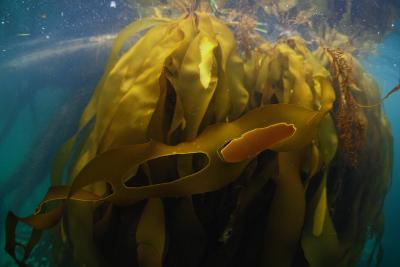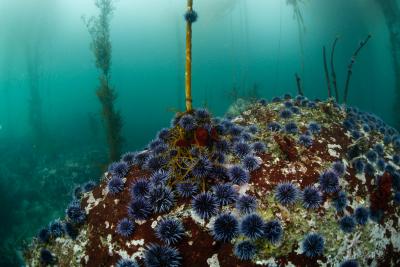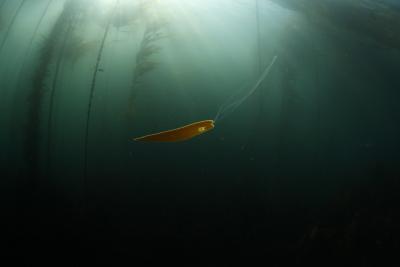Preliminary ecological modeling results from research funded by California Sea Grant and the California Ocean Protection Council suggest that California bull kelp restoration efforts may be most successful when they are done early and using multiple strategies.

Bull kelp forests in northern California have experienced over a 90% decline in their historic mean coverage after a marine heatwave hit and urchin populations skyrocketed starting in 2014. There have been massive community, agency, and academic responses to this kelp loss, including millions of dollars invested in kelp restoration and research and hundreds of volunteer hours removing tens of thousands of urchins underwater.
These responses are inspiring—but will they work? There is no precedent to look to; no one has tried to restore bull kelp at this scale before. How many urchins need to be removed to get kelp forests back? If kelp is planted, will it survive, grow, and sustain a forest?
These million-dollar questions need to be tackled from every angle: from below with scuba divers, from above with state-wide adaptive management, and from all sides with ecology, geology, oceanography, and yes—math. Researchers Jorge Arroyo-Esquivel and Dr. Marissa Baskett from UC Davis are taking the latter approach. They developed a mathematical model to answer the question: which short-term strategy for bull kelp restoration has the biggest anticipated impact on the ability and rate of bull kelp recovery? Their research is part of the Sea Grant and Ocean Protection Council jointly funded Kelp Recovery Research Program project, A Multi-pronged Approach to Kelp Recovery Along California’s North Coast.
Using a dynamical population model informed by ecological data, the researchers tested how much coastline needs to be restored, how often restoration interventions need to occur, and what actions—urchin removal, releasing bull kelp spores, or bull kelp outplanting—are needed to shift barren rocky reef habitats in northern California back to into bull kelp forests. They tested the effects of each method at weak, moderate, and strong intensity.
The result: “Going hard, going early versus spreading restoration interventions less intensively over a longer period can speed up kelp recovery in our model,” said Baskett, Professor of Environmental Science and Policy at UC Davis.

Removing urchins and increasing adult bull kelp density early showed the best success for near-term bull kelp recovery. Giving bull kelp this boost all at once was more important than sustaining restoration over a longer time or trying to restore a larger area. This outcome is primarily due to the grazing behavior of urchins as represented in the model. Urchin feeding behavior is counter-intuitive when it comes to kelp. Most herbivores will eat more when there are more plants to eat. Urchins, however, voraciously graze live kelp when it is scarce, and slow down when it is abundant. When kelp is abundant, urchins can survive on the fallen blades that naturally drift to the seafloor, so they stop actively grazing live kelp. This behavioral shift is an important threshold to reach, and can explain why simultaneously removing urchins while increasing adult kelp provides the best chance of successful bull kelp forest recovery.
“Bull kelp is unable to recover where there is a certain density of urchins in our model. That density is critical for kelp restoration. That can be increased by planting more kelp. As kelp density increases, it supports more urchins without them eating all the kelp and returning to urchin barrens,” said Arroyo-Equivel, lead author for the study and a Ph.D. candidate in Applied Mathematics at UC Davis. In other words, “active grazing behavior of urchins is the main driving factor of both the possibility of recovery and its rate,” the authors wrote in the preprint version of their article in submission.
The model also indicated that it may help to have a continuous influx of bull kelp spores (i.e. kelp seeding), either naturally via proximity to reproductively mature adults in nearby forests, or through human intervention.
“Overall, the combination of increasing initial kelp density, reducing initial urchin density, and implementing an ongoing kelp seeding leads to the fastest kelp recovery,” they say in their preprint article. However, the optimal timing of these strategies is still unexplored and needs more research, as is the potential role of environmental conditions varying in time and space.

It is important to note that this model did not evaluate how urchins were removed, kelp spores were released, or adult kelp was planted. The model also did not explore how currents, temperature, turbulence, nutrients, or other physical factors affect bull kelp spore dispersal, how other algal species may compete with bull kelp, or how predators of sea urchins affect their density and grazing behavior.
It’s been eight years since the marine heatwave, and bull kelp forests are still at only about 10% of their historical mean coverage. Is there anything to do to help them make a comeback? Mathematical models informed by ecological knowledge are an important tool for this, providing informed starting places for on-the-ground restoration to increase the chance and speed of successful bull kelp recovery.
About California Sea Grant
NOAA’s California Sea Grant College Program funds marine research, education and outreach throughout California. Headquartered at Scripps Institution of Oceanography at the University of California San Diego, California Sea Grant is one of 34 Sea Grant programs in the National Oceanic and Atmospheric Administration (NOAA), U.S. Department of Commerce.